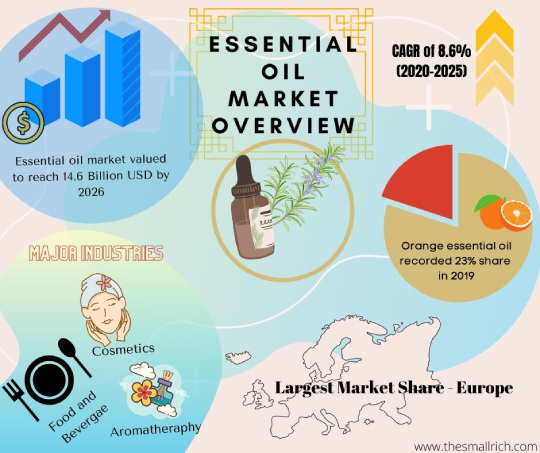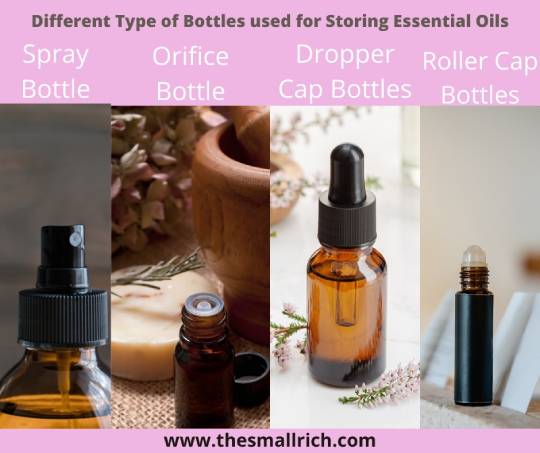An essential oil business involves in the extraction of compounds from various parts of the plants that were known to have aromatic nature. Once the compounds are extracted via distillation technique they are finally filled into containers and are marketed for various purposes.
What Market Research is Telling about the Essential Oil Business?
With increased awareness of health and wellness, people were now preferring products that include natural ingredients than synthetic’s. Making it one of the major driving factors for the growth of the essential oil business.
It was estimated that the market for essential oils is going to skyrocket from USD 7.03 billion dollars to a whopping 14.6 billion dollars by 2026.

Not only that, statista had revealed that the global market demand for essential oils is expected to reach 404 Kilotons by 2025 from just 226 Kilotons in 2018!
Taking into account the growing market and popularity. Starting an essential oil business is definitely a profitable one. If you are looking to start your own essential oil company then this is the right time for you.
The 10 Steps Involved in Setting up an Essential Oil Business
Step 1: Creating a Ground Plan for your Business
The first step in starting your essential oil business is to have a ground plan.
Basically, a ground plan creates a basic structure about your business in initial stages. This will give you an idea on budget, raw materials, and marketing strategies required for the business.
When it comes to essential oil business, it involves common things like, estimating the costs for raw materials, wages to workers, power supply, transportation, and other miscellaneous things.
In addition to this, you will decide what kind of essential oil to produce and extraction techniques to follow.
At the same time you will have to think about your production capacity , land requirement and distillation equipment.
Step 2: Obtaining Licenses and Permits
Every business must and should require certain licenses and permits to run. Generally, these thing’s depend on the type of business model, investment, and products you manufacture.
Some of the common things involved in setting up this business Include, Compay Registration. These can be either a sole proprietorship or partnership or an LLP company.
Giving a Trendy name to your essential oil business while registration is not only easier to remember but also acts as a selling strategy.
Also, see if you can trademark your essential oil business name. Although, not all countries might allow you to do this. However, if you have the opportunity don’t forget to file one for your brand.
Next, Obtain appropriate Safety, labor and industrial permits for running your plant. Although, essential oil extraction process may not produce loud noise or release harmful chemicals to the environment. But the handling of the equipment must be done properly in order to avoid safety issues.

Step 3: Deciding a Variety of Essential Oil to Manufacture
Essential oils are obtained from a variety of plants and there are different techniques involved in extracting process.
But the question is, you need to know what variety of essential oil can be profitable for you.
For example, essential oils like lavender, tea tree, and peppermint already have a great demand in the market and it can be competitive to manufacture and sell such types of products. Because several big companies, as well as established brands, already have manufactured products based on these ingredients.
On other hand, there are some lesser-known essential oils like clary sage, ginger, cypress and frankincense oil. Try if you can distill such unique products.
Step 4: Planning and Obtaining Raw Materials
Essential oils are extracted from various parts of the plant such as flowers, stems, leaves, and fruits. A proper strategy is very important on obtaining these raw materials.
There can be several scenarios that can affect your raw material supply such as, natural distastes, riots or sudden increase in prices. To be prepared for such things a proper planning is essential for procuring raw material
Here are some useful tips on how to plan your raw materials appropriately
- Never depend upon a single trader for obtaining raw material, instead tie up with multiple traders for uninterrupted supply
- Make sure you have a dedicated warehouse for storing raw materials
- Always be vigilant on market prices and set aside some amount of money for an unexpected price increase.
- Obtain raw materials from trusted sources that were known to grow organically. Although, getting raw material from an organically grown farm might initially cost you more, they would offer better quality and prevent unnecessary contamination in your end product.
Step 5: Cleaning and Sorting of Raw Materials
Once the raw material reaches your production plant, you need to sort out the material from unwanted waste such as foul plant substances, insects, dust, and debris.
Proper cleaning and sorting of raw materials will ensure your product is free from contamination as well as remains in good condition throughout its shelf-life.
Cleaning and sorting of raw material can be achieved quickly with a combination of manpower and automated equipment.
Step 6: Distillation and Extraction of Essential Oils
The core aspect of the essential oil business lies in the distillation techniques used. There are different varieties of extraction processes suitable for each type of essential oil.
Different types of techniques are involved in the distillation of essential oils
- Water distillation
- Steam distillation
- CO2 extraction
- Enfleurage
Among them, Water and Steam distillation are the widely used methods
Water Distillation
It is known to be an age-old technique. Where the plant materials are immersed in water. Later, a direct fire is applied beneath the distillery.
Once the temperatures slowly start to raise, the water and the plant material slowly boils and releases vapors.
These vapors travel through the still and reach the condenser which finally cools down the vapor turning into a liquid form.
These condensate will be further passed through the Florentine receiver, which separates the essential oil from the water.

Steam Distillation
Steam distillation is the most widely used essential oil extraction method all over the world. This is simply known as the industry-standard.
In this process, a separate compartment is installed to generate the steam for the extraction process. The generated steam will either be sent directly into the plant material or through the jacket.
As the plant material gets heated up it will slowly release the vapors that travels through the condenser finally producing essential oils.
Most of the industrial steam distillation machines are automated
Which means, they include a PLC to monitor various parameters of the equipment such as temperate, pressure, and humidity.
In addition to that some equipment’s even help to track the data of the batch.
Things to keep in mind while purchasing a distillation unit for essential oil extraction
The distillation unit is the heart of essential oil extraction. You need to pay special attention when purchasing this equipment.
Before you decide to purchase one, ask yourself following questions
- What is the capacity of the machine?
- What type of material is it made up of?
- Does the metal react with your essential oil material?
- How easy is it to clean and sterilize?
- How simple is it to operate?
- Does it offer any automation process?
- How much temperature can it withstand?
- Can the distillation unit be expanded over time, like the addition of valves, sensors, and pipes, etc.,
2) Always research and contact as many Essential oil Distillery equipment manufacturers as possible and ask for a quotation. Get a product brochure if possible.
3) Take a note of each equipment and its specifications and compare them with your requirements.
4) Write down the pros and cons of each equipment that you came across.
5) Try to contact existing customers who already made a purchase from the manufacturer that you are going to purchase.
6) Always go with the manufacturer that can provide better customer support and field technicians as soon as possible.
Step 7: Collection and Post-processing
After the process of distillation, the condensate is extracted through a receiver present at the bottom of the equipment. It is a mixture of water and essential oil. So, we need to separate the essential oils from water.
To do this, we use equipment called Florentine flask which is also known as Essencier. The shape of this flask is specially designed in such a way that it would separate the oils from the water.
There are two common types of Florentine flasks, One, that can separate low-density oil from the water like lavender oils. While, another, that can separate high-density oil from water. For example, cinnamon and clove oil.
Once the essential oil is separated from the hydrosol (water) it is further sent to processing where the oil will be constituted with a carrier oil.
However, some essential oils are not diluted and were packed directly into bottles.
Essential oils are diluted with a carrier oil because they were highly volatile in nature, which means they can easily get evaporated .
How to Effectively Use the Left over Hydrolate
The left-over Hydrolate or Hydrosol is a byproduct of distillation process. It is generally called as floral water.
Although we call it a byproduct it still retains a good amount of essential oil compounds within it. Thus, making it a valuable product in the Essential Oil Business. It is used in making products like face mist, toners, Make-up cleansers, or herbal water.
Benefits of using the Cohobation Technique, In the process of Cohobation, the hydrolate can be recycled for specific intervals back to the vessel. This will help to improve the essential oil yield at the same time increases the concentration levels of the compounds.
In the process of rose essential oil extraction, cohobation plays a major role where, 70% of the rose oil is obtained via this method.
Step 8: Packing and Bottling your essential oil
Once the essential oil is finally extracted, It needs to be packed into bottles. Most of the essential oils are packed into small glass bottles. They were usually stored in 15ml, 20ml, and 25 ml sizes.
However, some essential oils are packed in large sized bottles
Things to keep in mind when you are storing and packing essential oils
Most of the essential oils are packed in a brown colored small bottles, these colored bottles protect essential oil from UV-Rays at the same time they were inexpensive.
Different Types of Bottles Used for Essential oils Storage

Bottles with orifice reducers
This type of bottles contains an orifice. which is a small plastic material that reduces the flow of oil dripping outside when tapped. This ensures the oil is dispensed in small amounts.
Drawback – Bottles with orifice reducers are prone to dispense more liquid when tapped continuously which results in wastage. At the same time they were known to spill out the liquid around the mouth of the bottle.
Bottles with dropper caps
Bottles with dropper caps are more common in cosmetic and pharmaceutical industry. They dispense accurate amount of liquid drops when pressed. Making them most suitable bottles to store essential oils.
Bottles with roll-on cap
Bottles with roller caps are used if your essential oil needs to be directly applied over the skin or any surfaces.
In general, if an essential oil is packed in roller cap bottles then they were mostly diluted with carrier oil to prevent evaporation as well as to prevent any irritation on sensitive parts due to direct contact.
Spray bottles for essential oils
Some essential oils are often stored in spry bottles. These bottles contains a spray unit that releases fine mist when pressed.
If you were deciding to store your essential oil in spray bottles, then it is better to choose the one made up of glass or aluminum rather than plastic. Because plastic tends to react with essential oils.
Step 9: Branding and Marketing your essential oil business
Branding and Marketing are the two important things to turn your Essential oil business profitable. To simply say, without them, it is really hard to succeed in this business.
A Successful branding and marketing strategy involves a well-planned strategy and thorough research. Keep in mind this will not happen overnight. It requires dedication and time.
Steps involved in Branding and Marketing for Essential Oil Business
Creating a Strategy
Explain how your essential oil business is trustworthy, unique and how your customers feel about it.
In the brand strategy, you send a message to the public of your promises and purposes. And how your essential oils are unique from your competitors and what they were going to offer different from them.
Never try to skip creating a brand strategy at first, this will always remind you about the sole purpose of starting your business, it reflects your brand values and promises.
Establishing a Brand Identity
A brand identity gives visual representation to your business and its products. Generally, it involves things like
- Creating a logo
- Setting up a dedicated website
- Uniqueness in labelling, printing and packing of your essential oil products.
Marketing your Essential Oil products
Clear and consistent communication is very important in marketing your business.
Several small businesses either fail or lose so much amount of money in marketing their products. So, be careful and take your time on finding the correct resources to market your products.
Here are some economical ways that you can improve your market reach.
- Maintain a blog on your company website and timely post articles about your industry or products
- Make use of social media platforms like Pinterest, Facebook, and LinkedIn to promote your business
- Use social media marketing campaigns with low investment first
- Invite upcoming YouTube, Instagram stars to try out your essential oil products
- Set-up stalls in events or exhibitions to showcase your products
Keep in mind, to stay in the competition, try to provide discounts, coupons, and gift cards for purchasing your products during festive seasons.
At the same time, try to sell your Essential oils in starter kits. Because when you sell in starter packs you will provide more items in a single purchase. This attracts customers at the same time they can get to know more number of your products in their first purchase.
Step 10: Choosing Between Essential Oil Distributor and Online platforms to sell your products
There are two ways of selling Essential Oils, through a distributor or by your own.
Essential oil distributors are the ones that sell your product on their behalf with a commission. They play a major role in this kind of business, due to their vast sales network locally and internationally.
Get in touch with the distributors in your region and talk about how they can sell your products and how much they take a commission.
Or,
The second way, you can sell the products being a direct supplier.
Here’s the list of online platforms that you can start selling your own essential oils
- Shopify
- Amazon
- Bonanza
- e-bay
- Etsy
- facebook marketplace
What are some of the Best Brands in Essential oils?
do TERRA, Young Living, Rocky Mountain Oils and Plant Therapy are some of the reputed brands that are know to produce high-quality essential oils
Is Essential Oil Business still a Profitable One?
Yes, Essential oil business is still a profitable business. Though, there are several giants existing in this market, if you can focus on producing unique essential oils and have a Unique Selling Proposition, maintain quality in your product and packing, then you can achieve good growth in this business
Are Essential Oils FDA Approved?
FDA put forwards several questions whether to consider essential oils are approved or not. There are several reasons why it’s tricky because they are marketed as ‘aromatherapy’ products which itself is not clear whether they were a cosmetic product or a drug substance. if it is a cosmetic product, FDA states they have no legal authority to approve such products with few exceptions
What Licenses are needed for selling Essential oil?
Apart from business licenses, you don’t need specific licenses for selling essential oil products. However, if you claim that your product has medicinal claims then, you may have to check with the appropriate Drug or Medical regulations of that country you are selling. However, some countries like Canada requires to meet specific guidelines if you make your own essential oils
What are the steps involved in starting an essential oil business?
1) Obtaining Business licenses
2) Deciding thorough market research on what variety of essential oils to produce
3) Deciding whether you make your own essential oils or sell on behalf of others
4) Deciding a marketing strategy for branding and promotion
5) Deciding how you sell, working with an essential oil distributor, or as a direct supplier
